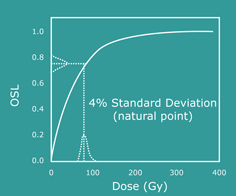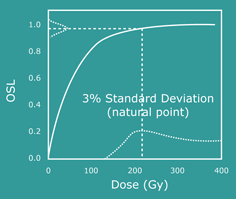Optically Stimulated Luminescence Dating
StrataData offers a dating service using the Optically Stimulated Luminescence (OSL) technique. This is done in collaboration with the University of Oxford Luminescence Dating Laboratory. Although a relatively new technique, particularly in subaqueous sediments, StrataData have pioneered its industrial application in dating superficial seabed deposits for geohazard risk assessment.
Application
Suitable for samples up to about 150Ka containing quartz. The quartz can be very fine grained (c.5um). Ideal for young sediments with no biogenic material present or where the age of the sediments exceeds the range of 14C dating (c. 40Ka). Requires precise measurement of sample water content and salinity.
Cost and turnaround time
The basic cost is £550/sample plus reporting time based on your requirements. The report will contain OSL results calibrated for sample water content and salinity. Turnaround time is several weeks to several months and very dependent on the time taken to prepare the samples, with organic rich samples taking the longest. Please contact us for more information.
Technical Information
|
Method All sediments contain trace minerals including uranium, thorium and potassium. These slowly decay over time and the ionising radiation they produce is absorbed by other constituents of the sediments such as quartz and feldspar. Stimulating samples using infrared light causes luminescence, the intensity of which varies depending on the amount of radiation absorbed. Exposure to sunlight resets the luminescent signature and so the time period since the sediment was buried can be calculated. The method is routinely applied to sediments as old as 250Ka and, consequently, is ideal for dating material beyond the range of 14C dating (>40Ka). A short length of undisturbed core is sub sampled in a dark room to extract a few grams of sediment. A residue of pure quartz is extracted by chemical digestion in hydrochloric acid, hydrogen peroxide and fluorosilicic acid, in a process which may take several weeks. The luminescence of each sample is measured using industry-standard Luminescence Readers (manufactured by Risoe National Laboratories, Denmark) which incorporate 90Sr beta-sources, and 470nm LED optical stimulation. The total absorbed dose (termed De, measured in units of Gy) is measured using standard luminescence dating procedures (Murray and Wintle, 2000). Quartz purity is monitored using infra-red (830nm) stimulation within the standard dating procedure. Calculation of the annual dose rate is based on the measured quantities of Uranium, Thorium and Potassium from the sample. This is done using standard ICP-MS and ICP_AES techniques. |
|
|
|
|
|
Figure 1a: Interpolation for a relatively young sample |
Figure 1b: Interpolation for a relatively old sample |


